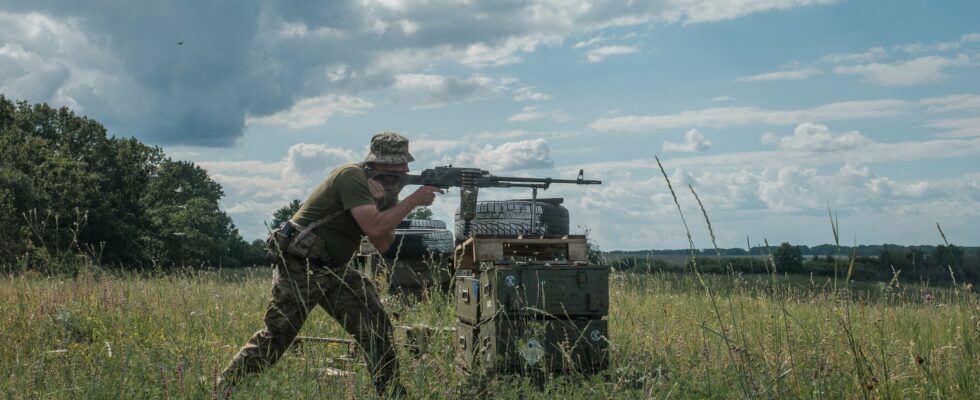He himself admits that the situation is “very difficult”. In his first interview with a Western media outlet, the British newspaper The Guardianthe new chief of staff of the Ukrainian army, Oleksandr Syrsky, is not pretending. “The Russian aggressor is attacking our positions from many directions,” explains the man who replaced Valeri Zaluzhny as head of the Ukrainian army last February. “But I know that we will win. I know how I have to go about it. And I am sure that we will succeed.”
In this interview, conducted in a secret military base in Ukraine, Oleksandr Syrsky also gave some indications on the current balance of power between the Ukrainian and Russian armies. While the latter is quite clearly in favor of Moscow’s troops, Ukraine also has significant advantages, particularly in its vision of a more defensive war.
Soldiers mobilized on the front: advantage Russia
In terms of soldiers on the front, the observation is clear: the Russian army has a clear advantage over the Ukrainian forces. According to General Syrsky, “their initial invasion force of 100,000 men has grown to 520,000 men. And their goal is to reach 690,000 men by the end of 2024,” he recalls in the columns of The Guardian.
Concerning Ukraine, as since the beginning of the war, the chief of staff refused to give precise information on the number of soldiers engaged. But one thing is certain: kyiv has been facing significant difficulties for many months in renewing its forces on the front. A controversial and unpopular law on conscription was adopted last April, extending mobilization to young people aged 25 to 27. But it has not yet succeeded in balancing the forces present.
Losses caused to the opponent: advantage Ukraine
Although Russian soldiers are more numerous, this does not prevent Ukraine from defending its positions hard and stemming the progression of the Russian army, causing significant human losses to the Russian forces. Those of the Kremlin are “three times” higher than on the Ukrainian side, and “even more” in certain areas, assures General Syrsky.
This subject of losses on each side is one of the most opaque in this war, and the numbers put forward by one side or the other must be taken with great caution. The most recent data, published on July 5 by Media Zone And Meduzatwo independent Russian media outlets, reported that the Kremlin forces had passed the 100,000 mark of deaths, with an estimate of between 106,000 and 140,000 dead as of June 21. The French Foreign Ministry claimed last May that the number of Russian victims had already exceeded 150,000.
On the Ukrainian side, Volodymyr Zelensky had declared last February that 31,000 Ukrainian soldiers had died since the beginning of the war. A number that is also certainly underestimated. General Syrsky has also refused to give a new estimate to The Guardianexplaining that the data was “sensitive” and a subject that Moscow could exploit.
While the exact number of military or civilian losses is therefore subject to great doubt, the dynamic remains certain: the slow progression of the Russian army is at the expense of an edifying human toll. At the end of May, British intelligence had estimated the average daily number of Russian victims at 1,200. A record since the start of the war. “They are managing to gain some ground, but at this rate, it will take them more than a century to conquer Ukraine,” General Jérôme Pellistrandi, editor-in-chief of the National Defense Review.
Equipment and weapons: advantage Russia, but…
In terms of equipment, at first glance, the Russian army also has a clear advantage. “In terms of equipment, there is a ratio of 1 to 2, or 1 to 3 in their favor,” General Syrsky insists in The Guardian. Since 2022, the number of Russian tanks has “doubled” from 1,700 to 3,500, he explains. Artillery systems have also “tripled,” and armored personnel carriers have increased from 4,500 to 8,900. “The enemy has a significant advantage in terms of forces and resources,” the Ukrainian chief of staff insists. “That is why, for us, the issue of supply and quality is really at the forefront.”
However, this quantity of supplies does not necessarily mean quality. “The Russian military has relied heavily on the refurbishment of Soviet-era stockpiles of weapons and military equipment to sustain the pace of its offensive operations in Ukraine, in order to avoid fully mobilizing the Russian economy and society in wartime,” explains The Institute for the Study of War (ISW) in its conflict daily of July 24. “Ukrainian authorities noted that Russia is currently not producing enough to cover its current equipment losses in Ukraine,” the authors of this note also add.
Ukraine, on the contrary, will continue to benefit from Western support, such as the new Patriot missile batteries that Kiev’s forces are expected to receive. The famous F-16 fighters, expected for many months, should finally arrive on the battlefield this summer, and help Ukraine defend its skies. “We do not fight by quantity but by quality,” assured General Syrsky, affirming that drones played “as important a role as artillery,” as the Ukrainian campaign in the Black Sea has proven. If Ukraine may not be able to reverse the situation on the front, as long as Western support – and especially American – lasts, it is difficult to imagine Russia making a major breakthrough.
